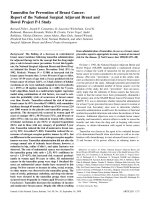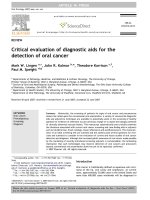Reducing the Risk of Breast Cancer With Medicine: A Guide for Women potx
Bạn đang xem bản rút gọn của tài liệu. Xem và tải ngay bản đầy đủ của tài liệu tại đây (641.26 KB, 16 trang )
Reducing the Risk of Breast
Cancer With Medicine
A Guide for Women
Fast Facts
n Most women will never get breast cancer.
n A woman’s risk of breast cancer increases with age.
n Two different medicines can lower the risk of some kinds of
breast cancer.
n Both medicines have side effects and sometimes cause serious
problems.
Inside
Risk of Breast Cancer 2
Learning About Breast Cancer 4
About the Medicines 6
Possible Benefits 7
Possible Problems 8
Thinking About the Decision 9
Questions for Your Doctor or Nurse 11
For More Information 12
What does this guide cover?
This guide can help you talk with your doctor or nurse about
medicine to reduce the risk of breast cancer. It talks about two
different medicines. It gives information about benefits, side effects,
and cost.
This guide is based on a government-funded review of research
reports about using medicine to lower the risk of breast cancer.
What is not covered in this guide?
This guide does not cover other ways to lower your risk of breast
cancer. It does not discuss having surgery to lower the risk of breast
cancer. It also does not cover reducing the risk of breast cancer in
men because these medicines have not been studied in men.
This guide does not talk about screening for breast cancer. It also
does not cover treatments for women who already have breast cancer.
Most women will never get breast cancer. A woman’s risk of breast
cancer depends on her age and other risk factors. Most women who
get breast cancer have no risk factors other than growing older. And
many women who have risk factors other than age never get breast
cancer.
The chart below shows how many women (out of 100) will get breast
cancer over the next 10 years. The risk of developing breast cancer
increases with age. By finding your current age, you will see the risk
of someone in your age group.
Risk of Breast Cancer
2
Number of Women Who Get Breast
Cancer Over 10 Years
Age Estimated risk
30 to 39 Less than 1 in 100
40 to 49 About 1 in 100
50 to 59 About 2 in 100
60 to 69 About 3 in 100
70 to 79 About 4 in 100
Estimated risk for women in the United States. This
information comes from Surveillance, Epidemiology
and End Results (SEER) Cancer Statistics Review,
1975-2005, National Cancer Institute.
Breast Cancer Risk Factors
Age
Getting older raises the risk of breast cancer.
Family history
Having a mother, sister, or daughter who had breast cancer raises the
risk.
Breast biopsy history
Having an abnormal finding on a past breast biopsy raises the risk of
breast cancer.
Menstrual history
Having your first period at an early age (before age 12) raises the risk.
Going through menopause late (after age 55) raises the risk.
Reproductive history
Having your first child later in life raises the risk of breast cancer.
Never having children also raises the risk.
Menopause hormone therapy
Taking hormones for menopause (estrogen alone or estrogen plus
progestin) raises the risk.
Obesity
Being obese (very overweight) raises the risk of breast cancer.
Alcohol use
Having more than one or two drinks a day raises the risk.
Other risk factors
It is rare, but some women are born with a gene that puts them at
high risk for breast cancer. Having radiation treatment at a young age
also raises the risk.
3
Learning About Breast Cancer
Breast cancer is a malignant (muh-LIG-nent) tumor that starts with
cells in the breast. Malignant means that the cells are cancerous and
may spread to other tissue in the breast. Sometimes the cancer cells
spread outside the breast to other parts of the body. This means they
metastasize (meh-TASS-ta-size).
Ducts in the breast carry milk to the nipple. Most breast cancers start
in the cells that make up the milk ducts. Some breast cancers start in
the lobules (glands where breast milk is made).
4
Breast Diagram
lobules
fatty tissue
nipple
milk ducts
A breast biopsy is the only way to tell if breast cells are abnormal or
cancerous. For a breast biopsy, a doctor removes a small piece of
breast tissue. The tissue is looked at under a microscope to check for
changes. If the cells are abnormal or cancerous, a biopsy may tell if
they are still in one place or if they have started to spread.
Non-invasive breast cancer
A non-invasive breast cancer is a growth of abnormal cells found in
the breast. The cells have not spread to other tissue in the breast or
other parts of the body.
n LCIS (lobular carcinoma in situ)—With LCIS, abnormal cells
grow inside the lobules. “In situ” means “in place.” The abnormal
cells have stayed in one place. LCIS rarely becomes invasive
cancer. But women with LCIS are at higher risk for invasive breast
cancer.
n DCIS (ductal carcinoma in situ)—With DCIS, abnormal cells
grow inside the milk ducts. It is called “in situ” because the
abnormal cells have stayed in one place. DCIS is the most
common non-invasive breast cancer. There is a chance that DCIS
might become invasive cancer later on.
Invasive breast cancer
With invasive breast cancer, the abnormal cells have spread beyond
the place where they started. Invasive breast cancer can start in the
milk ducts or the lobules. But “invasive” means that the cancerous
cells have spread to other breast tissue.
5
6
Two different medicines can reduce the risk of breast cancer for
women who have never had breast cancer before.
n Raloxifene (ra-LOX-ih-feen). It is only approved for use after
menopause.
n Tamoxifen (ta-MOX-ih-fen). It is approved for use before and
after menopause.
To reduce the risk of breast cancer, tamoxifen or raloxifene must be
taken once every day for up to 5 years.
How they work
Estrogen is a natural hormone found in the body. Some breast
cancers use estrogen to grow. There is a place on some breast cancer
cells, called a receptor, where estrogen can attach. This type of breast
cancer is called estrogen-receptor positive cancer.
Tamoxifen and raloxifene work by blocking estrogen. They attach to
the receptor, so estrogen can’t. Without estrogen, this type of breast
cancer cell can’t multiply and grow.
Some breast cancers do not have estrogen receptors. This type of
breast cancer is called estrogen-receptor negative cancer. It is not as
common, but it is harder to treat.
n Raloxifene and tamoxifen reduce the risk of breast cancers that
have estrogen receptors.
n They do not reduce the risk of breast cancers without estrogen
receptors.
About the Medicines
For women who have never had breast cancer, both tamoxifen and
raloxifene reduce invasive breast cancer risk by about 50 percent.
Possible Benefits
Raloxifene does not lower the risk of non-invasive breast cancers
(LCIS and DCIS). Research can’t tell us yet about tamoxifen and
non-invasive breast cancers.
For example, this chart shows the overall risk for women in the United
States age 50 to 59. Their risk of getting invasive breast cancer in the
next 10 years is about 2 in 100. This means that out of every 100
women, about 2 will get breast cancer. If all 100 of these women take
medicine to reduce the risk of breast cancer, about half as many (1
woman) will get breast cancer.
= the number of women who
will get invasive breast cancer
without taking medicine (2 out
of 100).
= the number of women who
will get invasive breast cancer
when all the women take
medicine (1 out of 100).
7
8
Both tamoxifen and raloxifene have common side effects. They both
can cause hot flashes. Tamoxifen can cause vaginal symptoms, like
itching, dryness, or discharge. Raloxifene can cause leg cramps.
Some women who have taken tamoxifen or raloxifene have had a
stroke. Research studies have found that the number of strokes in
women taking these medicines is about the same as in women not
taking these medicines. Talk with your doctor or nurse about your
risk for stroke.
Other serious and life-threatening side effects can also happen.
n Blood clots in the lungs and legs. Tamoxifen and raloxifene raise
the risk of blood clots. Blood clots happen more often with
tamoxifen than raloxifene.
n Endometrial cancer (cancer of the uterus lining). Tamoxifen
raises the risk of endometrial cancer. Raloxifene does not.
For every 100 women who take tamoxifen or raloxifene for 5 years,
the medicine will cause a blood clot or endometrial cancer in about 1
woman.
Possible Problems
Taking raloxifene or tamoxifen reduces a woman’s risk of some
kinds of breast cancer. Some women who take these medicines
will still get breast cancer.
Taking the medicines does not reduce the risk of dying from
breast cancer. It also does not mean a woman will live longer. It is
not clear why this is the case. Maybe the medicines reduce the
kinds of breast cancers that are easiest to treat.
Thinking About the Decision
Most women will never get breast cancer. But some women are at
higher risk than others. Talk with your doctor or nurse about your
risk of breast cancer.
Tamoxifen and raloxifene can lower the risk of getting some kinds of
breast cancer. These medicines also can raise the risk of serious
problems. Talk with your doctor or nurse about your risk for serious
problems from these medicines.
Think about these questions.
n Do I have a high or a low risk for breast cancer? Do I have a
high or low risk for serious problems from the medicine?
The risk of side effects should not be higher than the benefit of
the medicine.
n Can I stick with it?
These medicines need to be taken every day for up to 5 years.
They often can cause hot flashes.
n Does the cost of the medicines affect my decision?
The cost of the medicines may be important to you. They need to
be taken for a long time, and the cost can add up. Check to see if
your insurance covers using these medicines to lower breast
cancer risk. The chart on page 10 gives you an idea of the cost.
9
Price of Raloxifene and Tamoxifen
Drug Brand How Often, How It Price Per Month
2
Name Name Dose
1
How Long Is Taken Generic Brand
Raloxifene Evista® 60 mg Once a day
3
Pill NA $115
Tamoxifen Nolvadex® 20 mg Once a day Pill $115 $245
for 5 years
1
Doses are for reducing the risk of breast cancer.
2
Average Wholesale Price from Red Book, 2009.
3
We do not know yet how long raloxifene should be taken for breast cancer prevention.
NA = not available as generic.
10
Questions for Your Doctor or Nurse
n What is my risk for breast cancer? Is my risk higher or lower than
other women my age?
n What if I don’t want to start medicine at the age I am now? Can I
decide to start later?
n Is my risk for blood clots higher than usual?
n Is one of these medicines a better choice for me? Why?
n What help is there for side effects, like hot flashes?
n Can I do anything else to lower my risk for breast cancer?
11
Visit www.effectivehealthcare.ahrq.gov.
Click on Guides for Patients and Consumers to print a copy of this
guide and learn about other conditions.
For free print copies of this guide, call 800-358-9295. Ask the
Publications Clearinghouse for AHRQ Publication Number
09(10)-EHC028-A.
To learn more about breast cancer, visit the MedlinePlus Web site:
www.nlm.nih.gov/medlineplus/breastcancer.html.
For more information about breast cancer prevention, visit the
National Cancer Institute Web site:
www.cancer.gov/cancertopics/pdq/prevention/breast/patient.
For More Information
12
AHRQ Pub. No. 09(10)-EHC028-A
January 2010
The information in this guide comes from a detailed review of 123 research reports. The
review is called Comparative Effectiveness of Medications To Reduce the Risk of Primary
Breast Cancer in Women (2009) and was written by the Oregon Evidence-based Practice
Center.
The Agency for Healthcare Research and Quality (AHRQ) created the Eisenberg Center at
Oregon Health & Science University to make research helpful for consumers. This guide
was written by Erin Davis, B.A., Martha Schechtel, R.N., Bruin Rugge, M.D., and David
Hickam, M.D., of the Eisenberg Center. Women at high risk for breast cancer helped the
Eisenberg Center develop this guide.
Source









